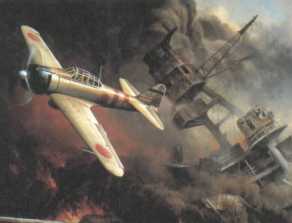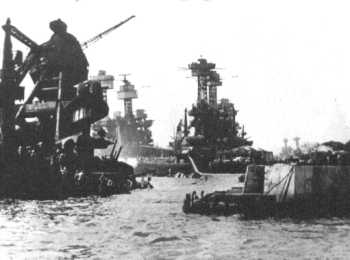|
War in
the Pacific: From Pearl Harbour to Midway

Japanese
attack on Pearl Harbour, Hawaii.
The United States was caught by surprise on the morning
of December 7, 1941, when 365
aircraft—bombers, fighters, and torpedo
aircraft—attacked the U.S. Naval Base at
Pearl Harbour, Hawaii, and
sank or severely damaged eighteen warships, destroyed or
damaged 347 aircraft, and
left 2,403 dead on the ground.

The reaction of the United States
was outrage at this undeclared act of war, and the
United States declared war
on Japan the next day. Three days
later, Hitler and Mussolini declared war
on the United States,
making the conflict truly a world war.
At the time of Pearl Harbour, the U.S.
aircraft carrier fleet was
out on manoeuvers and thus escaped
attack.

However, the effect of the
Pearl Harbour attack was to
bring the United States and Japan into a closer state of
military parity. Although
the attack, and the December 13
attack on the U.S. airfields in the Philippines
(which somehow also came as
a surprise), gave Japan the
momentary edge, and the United
States would be involved in a
theatre of war on the other side of the
globe, the industrial output of the United States would
clearly make up the shortfall in a year or so.

Naval photograph documenting the
Japanese attack on Pearl Harbour, Hawaii, which initiated
U.S. participation in World War II. Navy's caption:
Abandoning ship aboard the USS California after the ship had
been set afire and started to sink from being attacked by
the Japanese in their attack on Pearl Harbour on Dec. 7,
1941.
The strategy of the Japanese government
in 1941, as it had been twice before in the century, was to
fight a limited war until it gained its objectives, and then
dig in. The attacks on Pearl Harbour and the Philippines
were designed to buy the time needed to create new
boundaries in the Pacific.

Jumbled mass of wreckage of the U.S.
destroyers Downes (left) and Cassin (right), Pearl Harbour.
That the war turned into a contest to the
death was due in part to the unwillingness of the Japanese
military and the American political leadership to think in
such equivocal terms. The fighter aircraft that Japan
used to achieve early control of the skies were, as has been
pointed out, derived from American and British designs (the
Germans were much more circumspect about sharing their
technology with their Japanese allies), but the designers
at the chief manufacturers—Aicihi, Kawanishi, Kawasaki,
Mitsubishi, and Nakajima—took those ideas and pushed then in
new directions that astounded aircraft designers the world
over.
Moreover, unlike the Germans, the
Japanese kept developing their aircraft and creating
innovative designs. In fact, sometimes new models of older
fighters (like the A6M3, a new model of the A6M) were given
new designations because they looked like new airplanes even
to trained observers.
The greatest of these fighters, on a par
with the Spitfire and the Bf 109, was the Mitsubishi A6M
Reisen, identified officially by the Allies as “Zeke,” but
known throughout the war as the Zero. The Zero had a
manoeuvrability that seemed physically impossible to
American pilots; finding its weakness became a top
priority.
Painstakingly (and sometimes heroically),
pieces of downed Zeros were recovered and brought to Wright
Field in Day ton, Ohio, and pieced together. The engineers
found that the engine was modelled on an old Pratt &
Whitney that had been abandoned because of difficulty it had
in diving, and that the plane had virtually no protective
armour. The strategy developed for fighting Zeros was to
avoid engagements at close range, to attack from above,
forcing it to dive, its most vulnerable flight phase, and to
use wide-area explosives that would disable the aircraft
with even a glancing hit.
The key to the defeat of the Japanese air
force was not in the tactics used against the Zero, but in
the limited capacity of Japan to manufacture planes to
replace those downed. Of the five important Japanese
fighters deployed during the war, the Zero was produced in
the greatest numbers, but production reached only about
10,500.

The Battle of the Coral Sea in May 1942
was the first air battle
fought exclusively between aircraft carriers that never saw
each other.
The United States lost the USS Lexington (shown, with the
crew
abandoning ship as ordered) with thirty-three planes aboard,
but the Japanese were thwarted in their attempt to capture
Port Mores by, New Guinea, which would have cut off
Australia from the American fleet.

Mitsubishi A6M “Zero”

Nakajirna Ki 27 “Nate”

Kawasaki “Tony”
Outnumbered in the air three-to-one, the Japanese were
fighting a losing battle the minute the
United States entered the
war. Two
different philosophies informed the production of
Japanese planes during the
war. That the Japanese military
supported both and gave proponents of each
free rein to develop, make
their mistakes, and come back with
new machines showed
intellectual fortitude, during what was,
after all, a time of war.
The one approach had its roots in
the ancient martial disciplines in which the weapon was
an extension of the
warrior. The pilots of these aircraft
were all steeped in the martial art of Kendo
and practiced as much with
bamboo Shinai as with their training aircraft. The Nakajima
Ki 27 Nate, built in the mid
193Os, was a paradigm of economy and miniaturization:
a wing span of only
thirty-seven feet (11 in), a length of
less than twenty-five feet (7.5m), and virtually
nothing between the
pilot and the air save a thin metal skin
so loosely riveted that pilots felt the draft of
the onrushing air while in
flight.
The Ki 27 was manoseverable as few
fighter aircraft before or since, and it remained in
production throughout the early stages of the war.
The design approach of the Ki 27, the
brainchild of Hideo Itokawa
and Yasumi Koyama, was carried forth
into the Ki 43, a larger aircraft
that maintained its predecessor’s agility, but at
higher speeds. The plating protecting the plane
was still tissue-thin and the weaponry was
still minimal, but the plane had a larger cross-
sectional area, all of
which made the Ki 43 vulnerable (to some,
more so than the Ki 27).
The two Nakajima planes
became the mainstays of the
Japanese Army and were used
throughout the Pacific for most of
the war.
Meanwhile, the success of the
navy’s A6M Zero, a decidedly
Western airplane in conception,
fostered the second design path
the Japanese followed. The Zero gave
rise to the Ki 61 Hien, a
plane that melded the features of the
Zero with those of the Polikarpov 1-16 used by the
Soviets against the
Japanese in 1939. The basic problem
with the Ki 61 was its engine, a modified
version of an outdated
Daimler-Benz engine supplied by the Germans.
The Ri 61 was most
useful in defending Japanese targets
against Allied bombers and fighters and in any area
where it was likely to
encounter ground fire or fire from
enemy aircraft, resistance the other Japanese
fighter could not
withstand.
The two) basic approaches came together in
he Ri 84
Hayate, a Nakajima fighter
designed by Yasumi Kovama
that combined adequate protection and structure;
significant armament, and as much
of tile agility that the design
could incorporate. “Frank” fighters entered the fighting
in 1943 and some
thirty-five-hundred were built, but it
was too little too late to alter the course of the
war significantly.

Coral Sea Battle (click to enlarge)
The Hayate was seen by experts as the best
Japanese fighter of the war.
In May and June of 1942,
two battles, fought at great cost
to both sides, marked the turning points in the war:
the Battle of the Coral Sea (fought May 2-8) and the Battle
of Midway (fought June 4-.7). Both were called naval
battles, but they were fought by ships that never saw one
another and never, in fact, fired directly on an enemy naval
vessel. In both battles, the objectives were very similar:
the Japanese were seeking a foothold that would allow them
to isolate Australia from the American fleet, and the Allies
were determined to stop them.

Scene on board USS Yorktown (CV-5), shortly after she was
hit by three Japanese bombs on 4 June 1942. Dense smoke is
from fires in her uptakes, caused by a bomb that punctured
them and knocked out her boilers
Both battles ended with
the Japanese being forced to retreat, but whereas the
Japanese claimed victory at the Battle of the Coral Sea
because the Americans sustained greater losses, no such
claim was possible at Midway. The Japanese lost four
aircraft carriers and more than 330 aircraft to the
Americans’ losing only the Yorktown and 150 aircraft. Midway
was also the first battle for the CV 6 Enterprise, a name
that was to become synonymous with excellence in naval
aviation.

Midway Island
battle map.
(click to enlarge)
|
